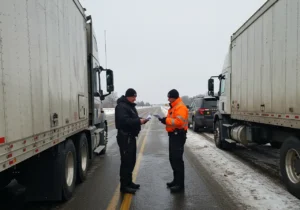As the trucking industry moves into 2025, significant regulatory changes are coming down the road. For carriers, owner-operators, and drivers in New England—Maine, New Hampshire, Vermont, Massachusetts, Rhode Island, and Connecticut—knowing about these changes early can help you avoid penalties, stay safe, and keep operations smooth. In this guide, we’ll cover the key regulations being adopted or enforced in 2025, what they mean locally, and how you can prepare.
1. Speed Limiter Mandate & Vehicle Control Technologies
One of the most discussed topics in 2025 regulatory changes is the proposed **speed limiter rule** for heavy trucks (usually Class 7 & 8, those over ~26,000 lbs). Trucks with electronic engine control units (ECUs) may be required to have a governor or speed-limiting device that restricts top speed – speculated to be in the 65-70 mph range.
In New England, with many rural and mountainous routes, steep grades, and variable weather, this has operational trade-offs: downhill braking demands, scheduling of deliveries, and driver training will be especially important. Fleet managers should verify which trucks already have speed-governors, test calibration, and keep documentation ready in case of roadside inspections.
2. Safety Tech Requirements: AEB, ESC, and More
 Another major regulatory push is for safety technology mandates. Automatic Emergency Braking (AEB), Electronic Stability Control (ESC), lane departure warnings, and similar driver assistance systems are being phased in for new heavy trucks. For New England fleets, these regulations mean investing in newer trucks or retrofits. Winter weather, icy roads, and narrow two-lane highways can stress those safety systems, so maintenance, calibration, and driver instruction are essential. Fleet insurance providers may offer incentives for well-maintained tech and demonstrable usage.
Another major regulatory push is for safety technology mandates. Automatic Emergency Braking (AEB), Electronic Stability Control (ESC), lane departure warnings, and similar driver assistance systems are being phased in for new heavy trucks. For New England fleets, these regulations mean investing in newer trucks or retrofits. Winter weather, icy roads, and narrow two-lane highways can stress those safety systems, so maintenance, calibration, and driver instruction are essential. Fleet insurance providers may offer incentives for well-maintained tech and demonstrable usage.
3. Drug & Alcohol Clearinghouse & Medical Certification Overhaul
Regulations for drug and alcohol violations are tightening. Drivers flagged in the FMCSA Drug & Alcohol Clearinghouse as “prohibited” must complete the full Return-to-Duty (RTD) process before driving again. State licensing agencies are increasingly enforcing downgrades or suspensions for unresolved violations.
Medical certification is also seeing modernization. Medical examiner certificates may need to be submitted electronically, more quickly after exams, and state agencies may intervene more aggressively if certificates are expired or invalid. For drivers in New England, where medical examiners may be more scattered in rural areas, planning ahead for appointments and ensuring paperwork is valid is key.
4. English Proficiency & Licensing / Identification Changes
An executive order and federal policy changes are pushing for stricter **English proficiency** enforcement for commercial drivers. This means drivers may be required, during inspections, to demonstrate basic ability to read safety signs, understand instructions, and communicate in English in safety-critical situations.
Also, licensing authorities will be reviewing non-domiciled driver CDLs more thoroughly; MC numbers (Motor Carrier operating authority numbers) are being phased out in favor of a unified USDOT number system. Fleet operators in New England should check state DOT / FMCSA communications to update registration, display numbers correctly, and ensure consistency in paperwork.
5. ELDs, Hours of Service (HOS), and Remote Inspections
Electronic Logging Devices (ELDs) remain a central compliance tool. In 2025, we expect stricter enforcement: devices that don’t meet technical standards may be revoked, and there will be fewer (if any) exemptions for older vehicles. Drivers must ensure ELDs are always functional, logs are accurate, and malfunctions are addressed properly. :contentReference[oaicite:8]{index=8}
Hours of Service rules are also under pilot programs and review, including possibilities for split sleeper berth time and more flexible rest break requirements. Remote or electronic inspections may become more common, especially for log-HOS compliance. For New England drivers, busy interstate corridors (I-95, I-91, I-84), multiple state boundaries, and seasonal weather can make HOS planning more complex.
6. Environmental & Emissions Regulations
Though many federal regulations on emissions have future effective dates, states in New England are moving ahead with strong environmental standards. Expect stricter state emissions inspections, incentives (or requirements) for zero- or low-emission trucks, and possibly new restrictions on diesel usage in certain regions or urban zones.
Carriers should keep an eye on both state regulatory agencies (e.g. Massachusetts Department of Environmental Protection, Vermont Agency of Transportation) and federal EPA changes to ensure trucks meet both emissions and fuel economy standards. Grants and subsidy programs may help offset upgrade costs.
7. How to Prepare: Compliance Strategies for New England Fleets

- Fleet Audit: Inventory your trucks, tech systems, ELDs, med-cert status, current speed limiter capability, safety tech installations, etc.
- Driver Training: Educate your drivers on the new requirements—especially safety tech use, English proficiency for inspections, hours of service scheduling.
- Documentation & Inspection Readiness: Maintain up-to-date maintenance and calibration records, medical certificates, ELD approvals, speed limiter settings, etc. Be ready for both state and FMCSA inspections or audits.
- Plan Budgets & Grants: Upgrade equipment in stages. Watch for state/federal grants in New England for clean trucking, emissions control, or safety tech. Factor in costs like retrofits, downtime, and training.
- Engage with State Agencies and Local Compliance Bodies: In New England, states can have additional requirements beyond federal law. Stay involved in associations (like state trucking associations), monitor state DOT, environmental & safety regulations and anticipate regional variations (e.g. cold weather, winter road conditions, snow, salt corrosion impacts on equipment).
Conclusion
2025 represents a year of major regulatory change for the U.S. trucking industry, and New England is not exempt. The trends toward safety-technology mandates, stricter enforcement of drug & medical regulations, language proficiency, unified registration, and emissions oversight all point toward safer roads but also require planning. By starting early with fleet audits, training, budgeting, and staying current with both federal and state rules, carriers and drivers in New England can stay ahead of the curve, avoid fines, and maintain reliable, efficient operations.
If you want more detail on any specific item—like speed limiter implementation, AEB retrofits, or med-cert digitization—stay tuned to NewEnglandTruckSeries.com as we’ll be posting deeper-dives in the weeks ahead.

